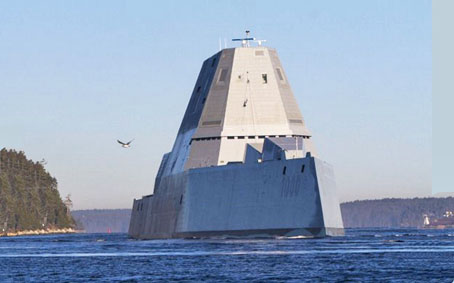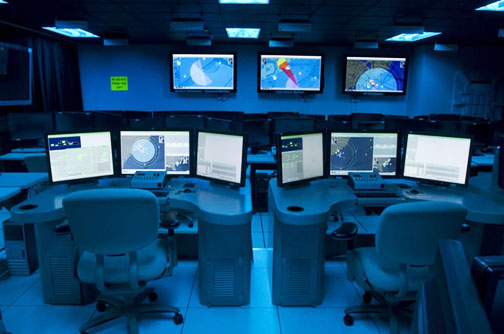By Jim Harrison
The destroyer Zumwalt has a face that only a mother could love — and radars can’t find. The new class of destroyer gives the U.S. Navy technological edges over any other ship, but not without a few design hiccups. Zumwalt is the first U.S. Naval surface combatant to feature all-electric propulsion. The DDG 1000 integrates two main turbine generators (from Rolls Royce), two auxiliary turbine generators, and two 34.6-MW advanced induction motors. The combined turbine engines are capable of producing 78 MW of electricity. The ship also has a powerful new gun system.

On December 7, 2015, the 610-foot-long ship left the Bath Iron Works shipyard in Maine for sea trials. The ship was launched in October 2013 and christened on April 12, 2014, but had many technical and program management delays. The 15,480-ton ship cost more than $4 billion — considerably over budget. The warship's angular surfaces and use of composite materials reduce its signature on radar to that of a fishing boat. Its computerized control systems will allow for a crew of only 158 — vastly reduced for a ship of such size and complexity.
Powerful armaments
The Zumwalt can shoot 155-mm rocket-powered shells 72 miles from two foredeck Advanced Gun Systems (AGS). The guns are designed to fire 10 rounds-per-minute per gun, sustained. It can also fire vertically launched Tomahawk or SM-2 missiles from tubes embedded in the deck using a new MK57 launch system.

In the command center is the ship’s Common Display System, which has a cluster of three-screen server workstations with Xeon processors and LynxOS-based virtual machines. The combat system is based on the Total Ship Computing Environment (TSCE), using open architecture, standardized software, and COTS hardware. Raytheon delivered more than 6 million lines of software for the DDG 1000.
Advanced propulsion, radar, sonar
The ship relies on the AN/SPY-3 X-band active electronically scanned array radar — which can provide guidance for the SM-2 and the Evolved Sea Sparrow missiles, but it can’t provide area air defenses because it lacks volume-search capability. Originally, the ship was supposed to have an S-band radar as part of an integrated dual-band system called the SPY-4, but that ran into technical trouble and cost issues and was removed in 2010.

The ship's Raytheon AN/SQQ-90 undersea warfare system includes AN/SQS-60 hull-mounted mid-frequency sonar, AN/SQS-61 hull-mounted high-frequency sonar, and AN/SQR-20 multi-function towed array sonar and handling system. The ship has two landing spots for helicopters.
Systems contractors developed the common data link (CDL) X/Ku-band phased array antenna systems, which are part of the integrated deckhouse assembly. The multi-beam, electronically steered antenna allows connectivity with up to eight CDL terminals.
System planning
As the costs of the program grew, the size of the planned fleet shrank. An original plan of more than 30 shrank to nine to seven and, ultimately, to three.
During recent sea trials, the Zumwalt's crew found a seawater leak in one of the two drive shafts' lube oil auxiliary systems, which forced her to return to Norfolk for assessment and repair. If the repairs can be completed in time, the Zumwalt will proceed to Baltimore for commissioning on October 15th before steaming for her new home port in San Diego, where it will complete activation and certification as part of an 18-month post-delivery “maintenance availability.”

But, to me, this ship looks a little like a cross between the Monitor and the Merrimac (1862). And besides, I can't find the front door.
Advertisement





